Sizzling Cast Iron Pork Tenderloin: Your Quick & Flavorful Weeknight Meal
Discover the secret to a fast, delicious, and incredibly juicy weeknight dinner with our Cast Iron Pork Tenderloin recipe. This method harnesses the power of a cast iron skillet to create perfectly seared pork tenderloin cubes, infused with aromatic Italian seasoning, a hint of smoky paprika, and a luscious drizzle of honey. The result is a delightful balance of sweet and savory flavors that will tantalize your taste buds.
Transforming a simple cut of pork into a culinary masterpiece, this dish is not only quick to prepare on your stovetop but also incredibly versatile. We love serving it alongside a vibrant, fresh orzo salad, making it an ideal light and refreshing meal for any season, especially spring. Get ready to elevate your dinner routine with this irresistible recipe!
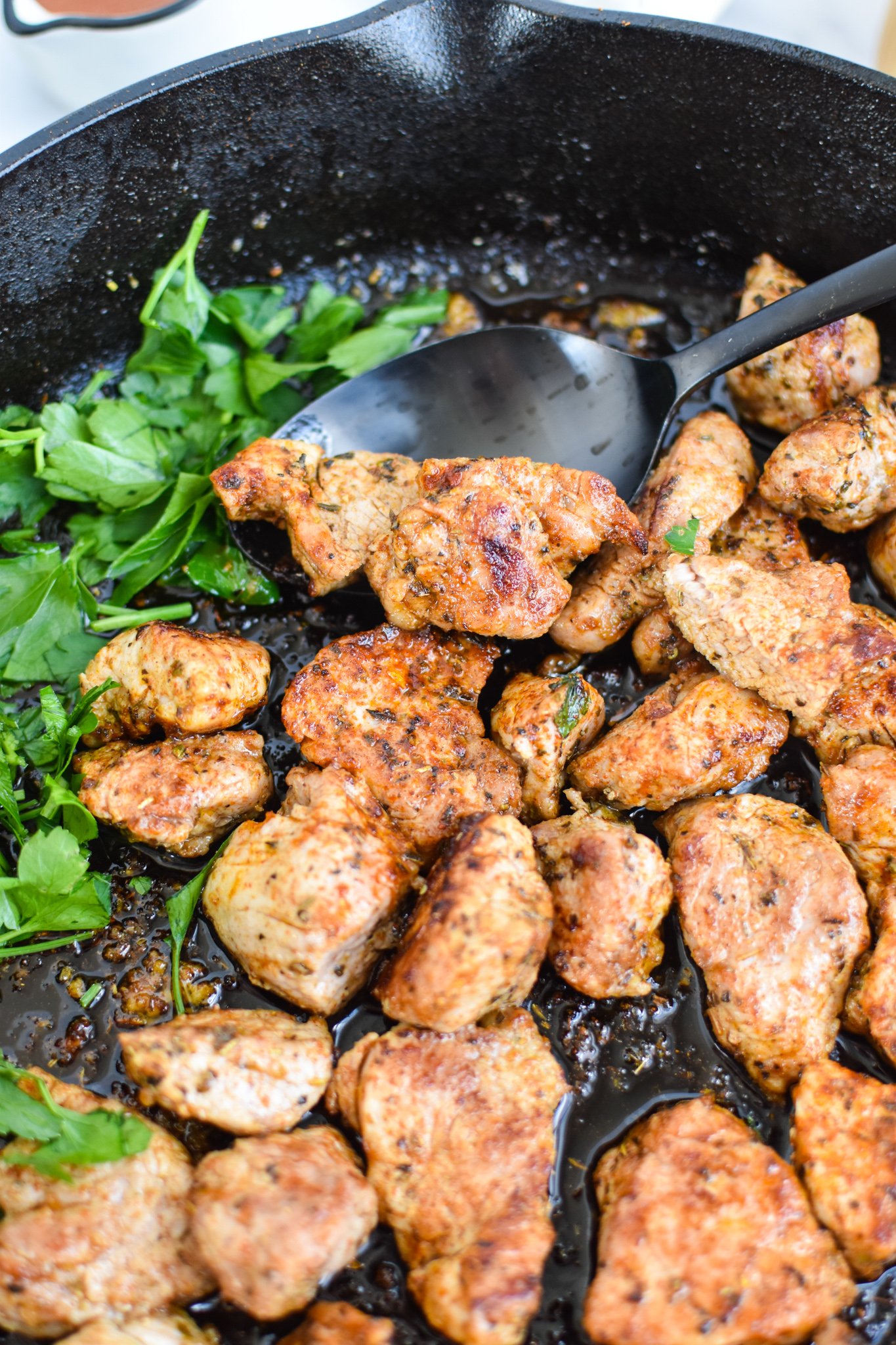
I know many of you appreciate the pork recipes I share, like the popular Slow Cooker Pork Tenderloin, my hearty Easy Pork Chili, and the succulent Slow Cooker Pork Shoulder Roast. This Cast Iron Pork Tenderloin recipe is designed to fit seamlessly into those busy weeknights, delivering a complete, satisfying meal in under 20 minutes of cooking time. It’s truly the epitome of a quick and effortless weeknight dinner.
If you crave that irresistible crispy sear on the outside while keeping the inside perfectly juicy, this method is undoubtedly the best way to prepare pork tenderloin. The cast iron skillet creates a beautiful, flavorful crust that locks in moisture, ensuring every bite is tender and delicious. You’ll especially love how the sweet notes of honey perfectly complement the subtle heat of paprika and the aromatic blend of Italian seasoning, creating an unforgettable flavor profile that sets this pork apart.
The magic truly happens in the cast iron skillet. It’s renowned for its ability to retain and distribute heat evenly, which is crucial for developing that desirable crust on the pork while ensuring it cooks through without drying out. This technique guarantees a juicy, tender, and incredibly flavorful piece of pork every single time.
For more fantastic pork meal ideas, be sure to explore my full collection of pork recipes here. You might also enjoy my BBQ Baked Pork Chops, the vibrant Easy Pineapple Pork Chops, the savory Parmesan Crusted Pork Chops, the comforting French Onion Pork Chops, or the simple yet delicious Slow Cooker Pineapple Pork Loin. Each offers a unique way to enjoy this versatile meat!
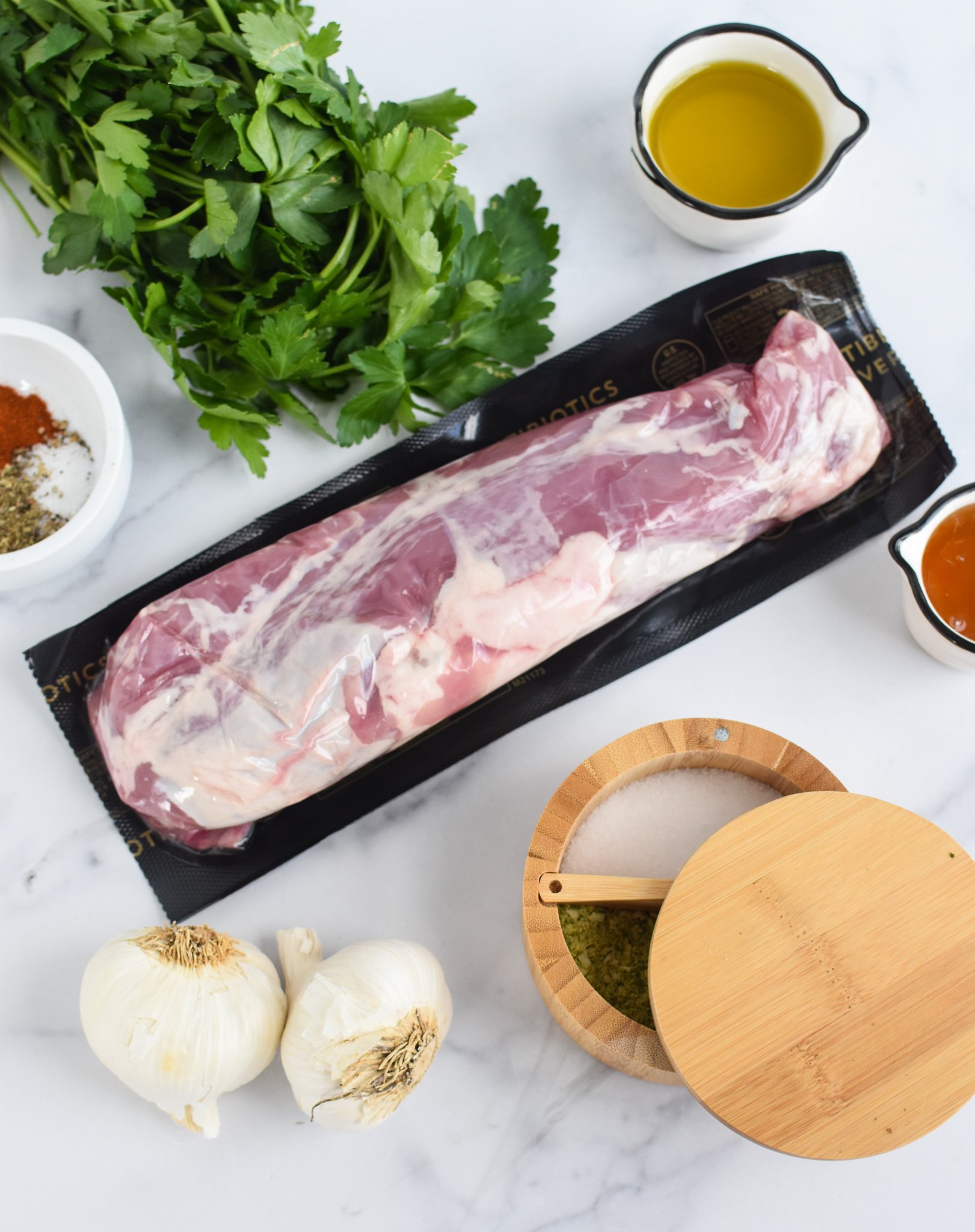
Essential Ingredients for Your Cast Iron Pork Tenderloin
Crafting this flavorful Cast Iron Pork Tenderloin requires a handful of simple, wholesome ingredients. Here’s a closer look at what you’ll need and why each component is essential for maximizing flavor and texture:
- Pork Tenderloin: The star of our dish! You’ll need a 2 to 2 1/2 pound pork tenderloin. This cut is naturally lean and incredibly tender, making it perfect for quick cooking methods like searing. Remember, the crucial first step is to carefully remove the silver skin before cutting it into 1-inch cubes. The silver skin is a tough, silvery membrane that won’t break down during cooking and can make the pork chewy.
- Spices (Italian Seasoning & Paprika): These two create a robust and aromatic rub for the pork. Italian seasoning brings a fragrant blend of herbs like oregano, basil, rosemary, and thyme, while paprika adds a warm, subtly sweet, and slightly smoky depth of flavor, contributing to the beautiful color of the crust. Feel free to customize this blend; a smoky BBQ rub or a Mediterranean spice mix would also work wonderfully.
- Honey: A crucial ingredient for that irresistible sweet-and-savory balance. Drizzled over the pork before cooking, honey not only adds natural sweetness but also helps create a delicious caramelization on the surface of the meat as it sears, enhancing the crust and flavor. Maple syrup or brown sugar can be used as alternatives if honey isn’t available.
- Garlic: Freshly minced garlic provides a pungent, aromatic kick that beautifully complements the other flavors. It’s mixed with the honey and spices to adhere to the pork, infusing every piece with its irresistible aroma.
- Olive Oil: Essential for searing the pork to perfection. Use a good quality extra virgin olive oil to coat the cast iron skillet, ensuring the pork browns beautifully and develops a crisp exterior without sticking.
- Orzo (for the accompanying salad): While the pork is delicious on its own, I highly recommend serving it with a fresh orzo salad. This recipe includes instructions for a vibrant herbed orzo salad that perfectly complements the rich flavors of the pork. Orzo is a small, rice-shaped pasta that makes for a light and refreshing side. You can use whole wheat orzo for an added boost of fiber. The salad is packed with fresh vegetables and herbs, offering a delightful contrast in texture and taste.
- Fresh Vegetables (for the Orzo Salad): Cherry tomatoes, English cucumber, and arugula add freshness, crunch, and a burst of color to the orzo salad. These ingredients contribute to the “light, spring meal” feel.
- Feta Cheese: Crumbled feta cheese introduces a salty, tangy, and creamy element to the orzo salad, balancing the herbs and vegetables.
- Fresh Herbs (for the Orzo Salad): Basil, mint, parsley, and dill are key to the vibrant, fresh flavor of the orzo salad. These herbs elevate the salad, making it aromatic and truly Mediterranean-inspired.
- Red Wine Vinegar & Lemon Juice (for the Dressing): These acidic components form the base of the zesty dressing, providing tanginess and brightness that cut through the richness of the pork and meld all the salad flavors.
- Salt & Black Pepper: Essential for seasoning both the pork and the salad, enhancing all the individual flavors.
For exact ingredient amounts and detailed step-by-step instructions, please refer to the complete recipe card provided below.
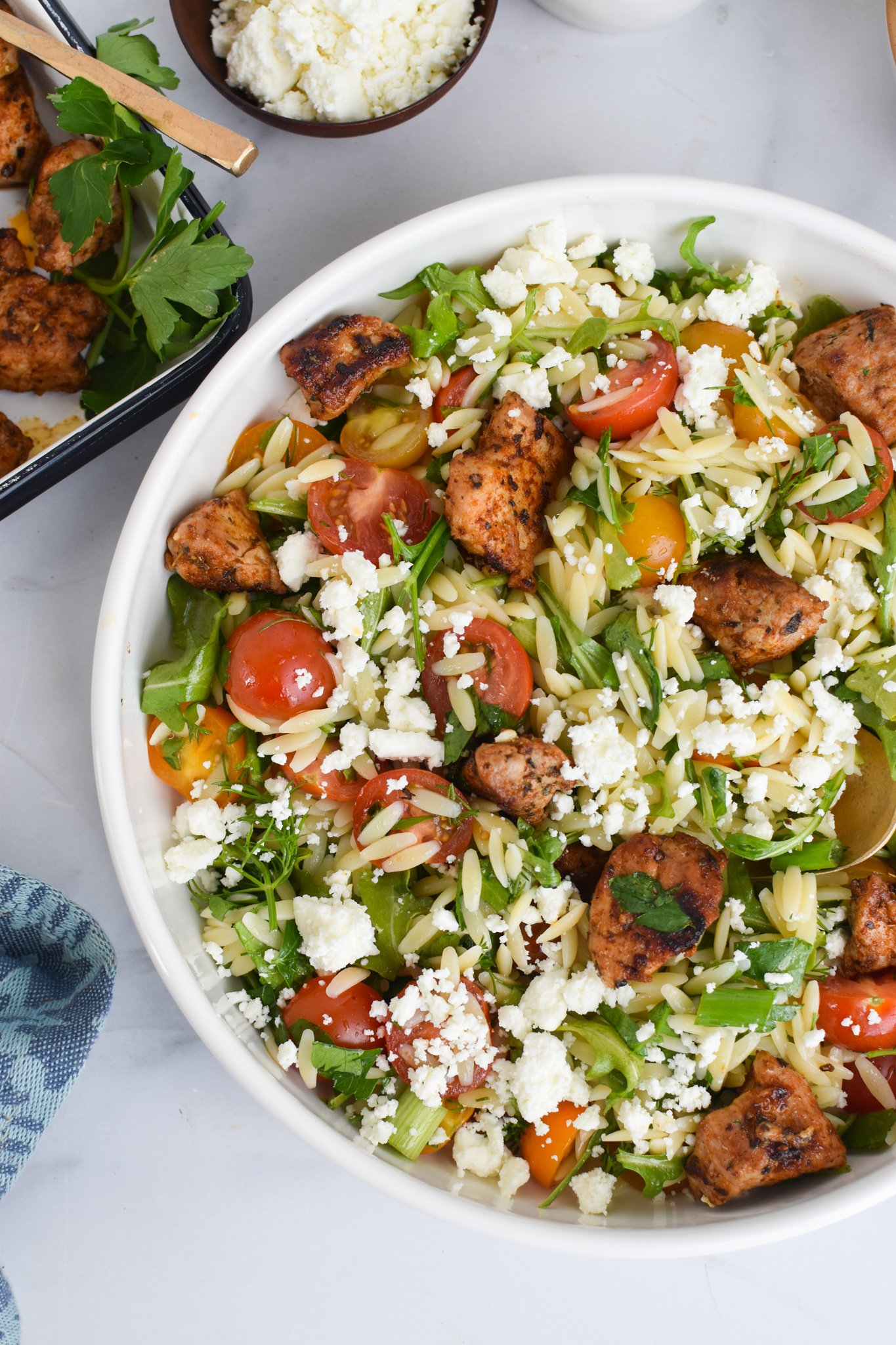
How to Make Sizzling Cast Iron Pork Tenderloin
Creating this flavorful Cast Iron Pork Tenderloin is surprisingly straightforward, making it perfect for even the busiest evenings. Follow these steps for perfectly seared and juicy pork:
Step 1: Prepare the Pork Tenderloin. Begin by carefully removing the silver skin from the pork tenderloin. This thin, silvery membrane doesn’t render during cooking and can make your pork chewy. Use a sharp knife, slide it under one end of the silver skin, and then firmly pull the silver skin with one hand while using your knife to gently separate it from the meat. Once trimmed, place the pork tenderloin on a large cutting board and cut it into uniform 1-inch cubes. Uniform pieces ensure even cooking.
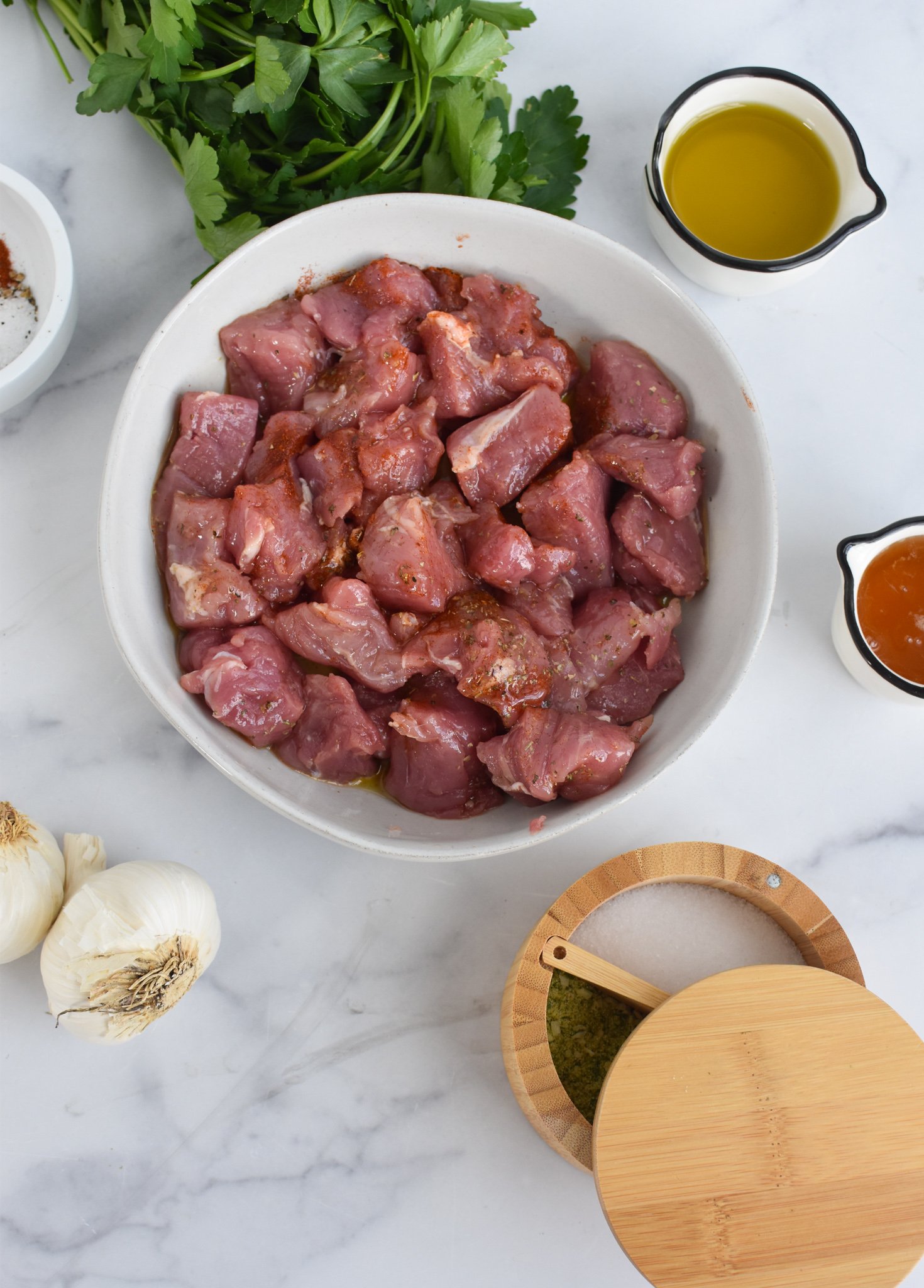
Step 2: Season the Pork. In a small bowl, combine the Italian seasoning, paprika, salt, and black pepper. Mix these spices thoroughly to create an even blend. Sprinkle this aromatic seasoning mixture generously over the pork cubes, ensuring all sides are coated. Next, drizzle honey over the seasoned pork, followed by the minced garlic. Toss everything together really well with your hands or tongs to ensure the honey, garlic, and spices are evenly distributed and adhere to each piece of pork. This step is key to building complex flavors.
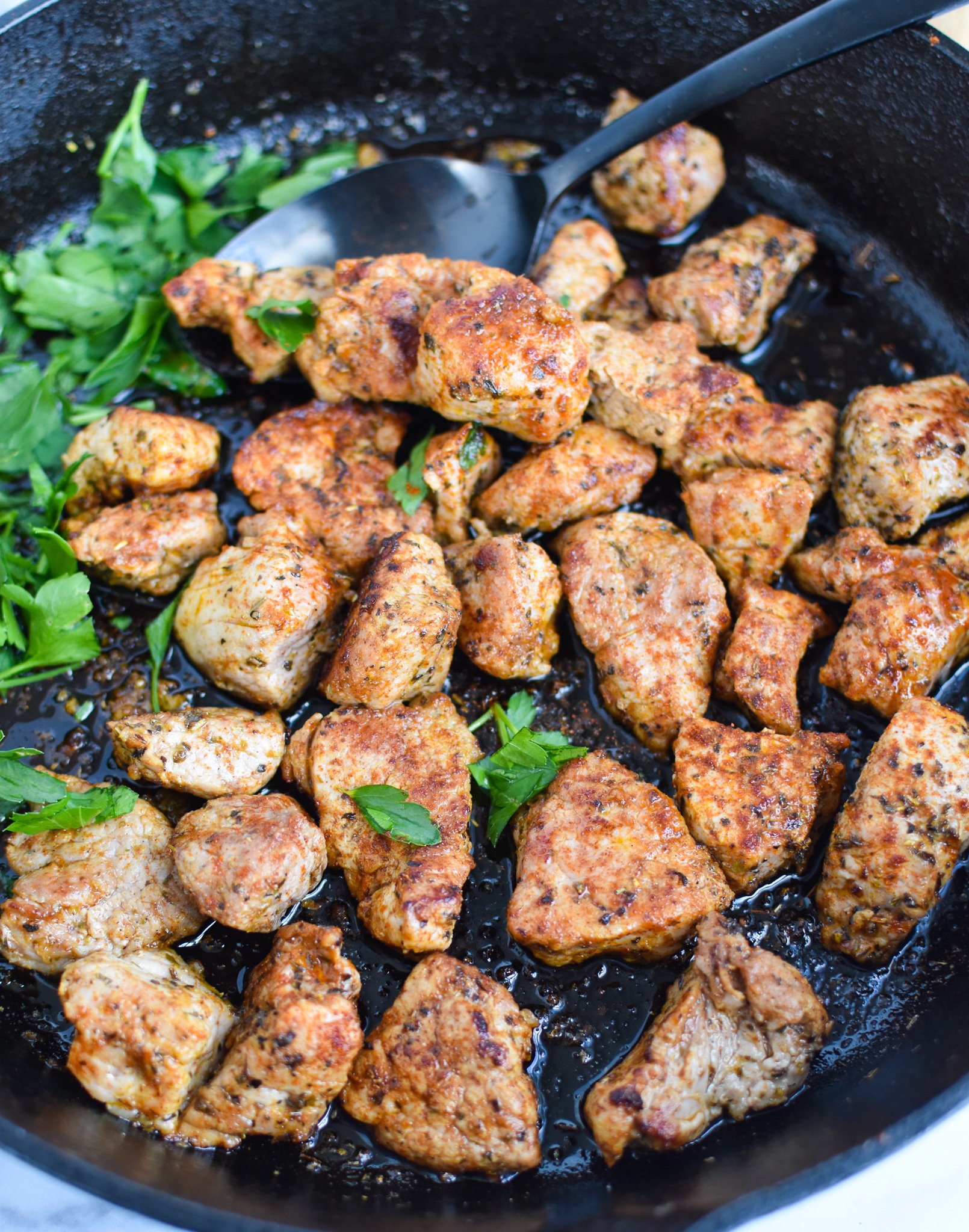
Step 3: Sear the Pork in a Cast Iron Skillet. Heat the olive oil in a large cast-iron skillet over medium-high heat until it shimmers. A properly heated skillet is crucial for achieving a good sear. Add the pork cubes in a single layer to the hot pan, being careful not to overcrowd the skillet. Cooking in batches if necessary will ensure the pork truly sears instead of steams. Cook for 10-12 minutes, stirring occasionally and flipping the pork over to brown all sides. Use an instant-read thermometer to check the internal temperature; it should reach 145 degrees F. This quick cooking time ensures the pork remains tender and juicy with a beautiful, delicious crust.
Step 4: Rest and Serve. Once the pork is cooked through, remove it from the skillet and let it rest for at least 5 minutes on a clean cutting board or plate. Resting allows the juices to redistribute throughout the meat, resulting in an even more tender and flavorful pork tenderloin. After resting and once slightly cooled, stir the delicious pork into your prepared orzo pasta salad for a complete meal. This dish pairs wonderfully with simple sides like roasted baby potatoes, sweet potato wedges, or steamed green beans. Store any leftovers in an airtight container in the refrigerator for up to 3-4 days, making it perfect for meal prep.
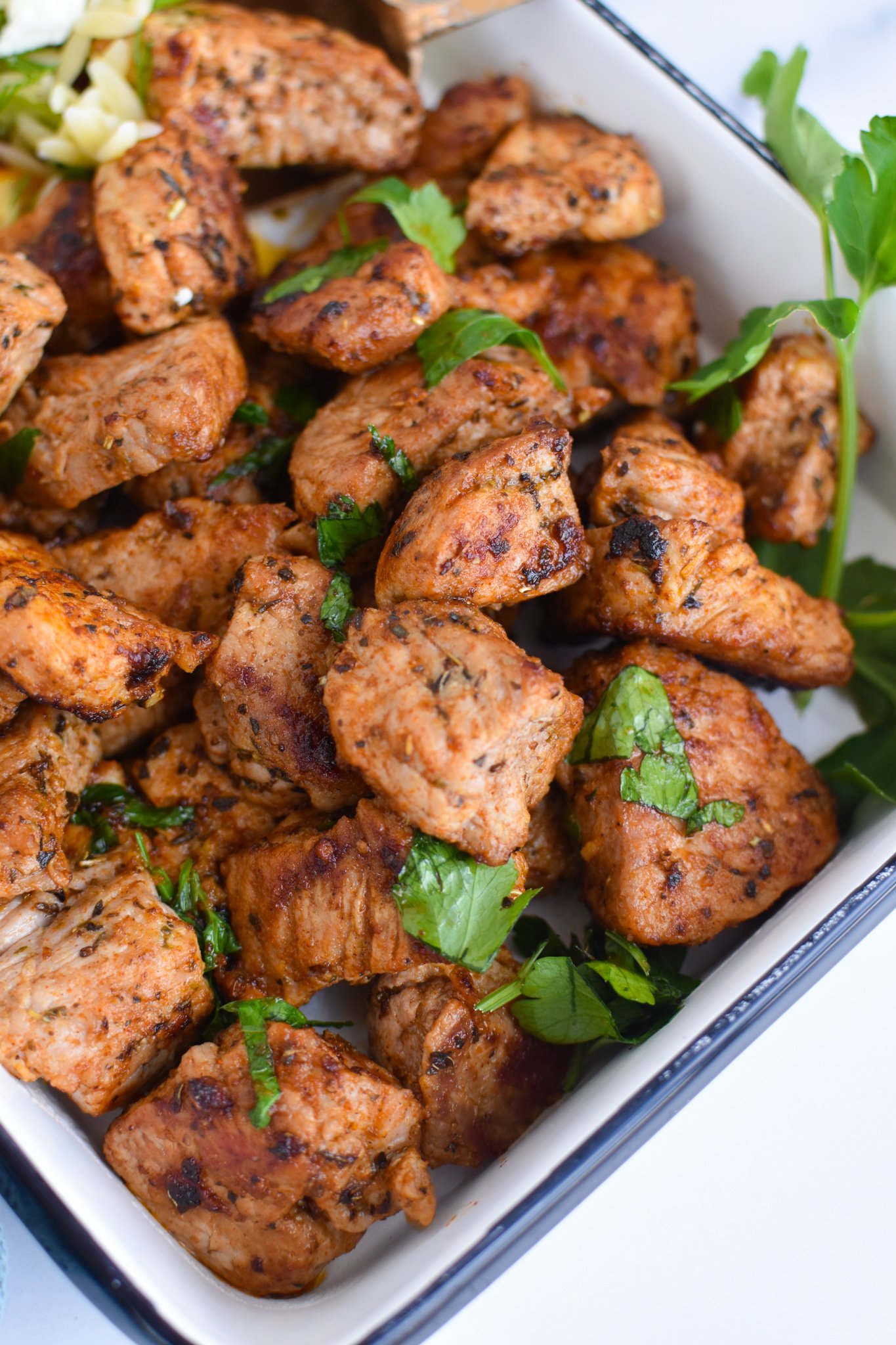
Achieving Perfect Pork Doneness: The Ideal Temperature
One of the most common questions when cooking pork is about its doneness. For pork tenderloin, the goal is to achieve a juicy, tender result without overcooking. The United States Department of Agriculture (USDA) recommends cooking pork to an internal temperature of 145 degrees F (63 degrees C). At this temperature, the pork may still have a slight blush of pink in the center, which is perfectly safe to eat and indicates maximum juiciness. Many people still mistakenly believe pork needs to be cooked until all pink is gone, but modern farming practices and guidelines confirm that a slightly pink center is both safe and desirable for optimal flavor and texture. Always use an instant-read meat thermometer inserted into the thickest part of the meat to ensure accuracy.
Pork Loin vs. Pork Tenderloin: Understanding the Differences
While often confused, pork loin and pork tenderloin are distinct cuts of pork, each with unique characteristics and best cooking applications. Knowing the difference is key to achieving the best results in your kitchen.
- Pork Tenderloin: This is a long, thin, and very lean cut of meat, typically weighing between 1 to 2 pounds. It comes from the muscle that runs along the pig’s backbone, which is not heavily used, making it incredibly tender. Because of its leanness and small size, pork tenderloin cooks very quickly, making it ideal for high-heat, fast cooking methods like searing, grilling, or roasting. It’s perfect for recipes like this cast iron pork tenderloin, where quick, flavorful results are desired.
- Pork Loin: In contrast, pork loin (also sometimes called loin roast or pork center rib roast) is a much larger, wider cut, often weighing 3 to 5 pounds or more. It comes from the back of the pig, closer to the ribs. It can be sold bone-in or boneless and has a thicker layer of fat. Pork loin is best suited for slower cooking methods such as roasting or slow cooking (like in a crock-pot) that allow its larger size and fat content to render and keep the meat moist. It can be cut into thick chops for grilling, but the cooking time will be longer than for tenderloin.
In summary, pork tenderloin is smaller, leaner, and cooks faster, while pork loin is larger, has more fat, and benefits from longer, slower cooking. Always check your recipe to ensure you have the correct cut!

Creative Ways to Customize Your Cast Iron Pork Tenderloin
This Cast Iron Pork Tenderloin recipe is a fantastic starting point, but don’t hesitate to get creative and personalize it to your taste. Here are several ways to modify this dish and explore new flavor profiles:
- Marinade It: For an even deeper flavor, consider marinating the pork tenderloin before cubing and cooking. A simple blend of olive oil, lemon juice, garlic, salt, pepper, and fresh herbs (like rosemary or thyme) can do wonders. For an Asian-inspired twist, try a marinade with soy sauce, ginger, garlic, and a touch of sesame oil. If you enjoy heat, add a pinch of crushed red pepper flakes or cayenne pepper to any marinade. Marinading for at least 30 minutes, or up to 4 hours, will infuse the meat with incredible flavor and tenderize it further.
- Fruit Glazes: Introduce a burst of sweet and tangy flavor by glazing the pork with a fruit-based sauce. Think sweet and savory options like a rich mango chutney, a bright apple cider glaze, or a zesty honey-orange sauce. These glazes can be brushed on during the last few minutes of cooking or drizzled over the cooked pork just before serving, creating a beautiful sheen and an extra layer of flavor.
- Mustard Coating: Mustard is a classic pairing with pork, and it’s a simple way to add a delightful tangy kick. Before seasoning, spread a thin layer of Dijon mustard or a coarse whole-grain mustard over the pork tenderloin cubes. The mustard not only adds a robust flavor but also helps to keep the meat moist and can contribute to a fantastic crust. For a more complex flavor, try mixing a bit of honey or maple syrup with the mustard.
- Herb Crust: Elevate the texture and aroma by creating a savory herb crust. Combine panko breadcrumbs with grated Parmesan cheese, finely chopped fresh herbs (such as rosemary, thyme, and parsley), and a touch of garlic powder. After seasoning the pork, lightly press this mixture onto the cubes before searing them in the cast iron skillet. The crust will become wonderfully golden and crispy, adding a gourmet touch to your dish.
- Spice Blend Variations: Don’t limit yourself to Italian seasoning and paprika! Experiment with different spice blends to explore a world of flavors. Try a Tex-Mex blend with cumin, chili powder, and oregano for a spicier, bolder taste. A Mediterranean blend with sumac and coriander, or a North African-inspired rub with ras el hanout, could also be exciting. Adjust the spices to match the side dishes you plan to serve.
- Add Vegetables to the Skillet: For a true one-pan meal, consider adding quick-cooking vegetables directly to the cast iron skillet during the last few minutes of the pork’s cooking time. Thinly sliced bell peppers, onions, zucchini, or cherry tomatoes can be tossed into the pan, allowing them to soften slightly and absorb the pork’s delicious juices and seasonings.

Frequently Asked Questions About Cast Iron Pork Tenderloin
Cast iron skillets are exceptional for cooking pork tenderloin because they excel at retaining and distributing heat evenly across the cooking surface. This consistent, high heat is crucial for creating that beautiful, crispy sear (or crust) on the outside of the pork, while simultaneously locking in the juices to keep the inside incredibly moist and tender. Many cast iron skillets are also oven-safe, offering the flexibility to start searing on the stovetop and finish cooking in the oven, all within the same pan, which is great for larger cuts or when you want a more hands-off approach.
Absolutely! While this recipe provides a quick and flavorful rub, marinating the pork tenderloin beforehand is an excellent way to add even more depth of flavor and tenderize the meat further. A simple marinade typically includes an acidic component (like citrus juice or vinegar), oil, and your choice of herbs and spices. Marinating for 30 minutes to a few hours can significantly enhance the final taste and texture of your pork.
Preventing dry pork tenderloin is all about proper cooking technique. First and foremost, avoid overcooking it; pork tenderloin is best when cooked to an internal temperature of 145 degrees F (63 degrees C), allowing for a slight blush of pink. Always use an instant-read meat thermometer to monitor doneness. Secondly, ensure your cast iron skillet is hot before adding the pork to create a quick sear that seals in juices. Lastly, and very importantly, let the cooked pork rest for at least 5 minutes before slicing. This allows the muscle fibers to relax and reabsorb the juices, ensuring a tender and moist result.
For searing in a cast iron skillet, it’s best to use an oil with a high smoke point. Olive oil works well, but other good options include avocado oil, grapeseed oil, or canola oil. These oils can withstand higher temperatures without smoking or breaking down, ensuring you get a great sear without imparting off-flavors.
You can certainly do some prep work in advance. The pork can be trimmed, cubed, and seasoned a few hours ahead of time and kept refrigerated. The orzo salad components can also be prepared (cooked orzo, chopped vegetables, dressing) and stored separately in the refrigerator. When you’re ready to eat, simply sear the pork, combine the salad ingredients, and toss with the dressing. This makes assembly very quick for busy weeknights.
Explore More Delicious Pork Recipes
Pork
Easy Thai Pork Stir-Fry
Mediterranean
Pork Souvlaki with Tzatziki
Pork
How to Cook Pork Loin in the Slow Cooker
Pork
How to Bake Pork Chops in the Oven
Tried this recipe? Leave a star rating and comment below! Subscribe to my newsletter or follow me on
Facebook,
Instagram, or
Pinterest for the latest.
Cast Iron Pork Tenderloin

Saved
Pin
Ingredients
- 2 to 2 1/2 pounds pork tenderloin, silver skin trimmed, cut into 1-inch cubes
- 2 tablespoons olive oil
- 1 teaspoon Italian seasoning
- 1 teaspoon paprika
- 3/4 teaspoon salt
- 1/4 teaspoon black pepper
- 2 teaspoon honey
- 3 garlic cloves, minced
- 8 ounces orzo pasta {try whole wheat for a healthier version}, cooked according to package
- 2 cups cherry tomatoes, halved
- 1/2 english cucumber, diced
- 1/2 cup crumbled feta cheese
- 1 cup of arugula
- 1/2 cup fresh basil leaves, chopped
- 1/4 cup fresh mint leaves, chopped
- 1/4 cup fresh parsley, chopped
- 2 tablespoons dill, chopped
- 1/3 cup red wine vinegar
- 1 lemons, juiced
- 1 teaspoon honey
- 1/2 teaspoons salt
- 1/8 teaspoon freshly ground black pepper
- 2/3 cup extra-virgin olive oil
Instructions
For the pork:
-
Remove the silver skin from the pork tenderloin and place the pork tenderloin on a large cutting board. Cut the pork into 1-inch cubes.
-
In a small bowl mix together the Italian seasoning, paprika, salt and pepper. Sprinkle the spice mixture over the pork.
-
Drizzle the honey over the pork and then mix in the garlic.
-
Heat the oil in a large cast iron or non-stick skillet over medium high heat.
-
Add the pork in a single layer and cook, stirring occasionally and flipping the pork over for 10-12 minutes, or until the pork reaches an internal temperature of 145 degrees F
-
Once the pork is cooked, let it sit for 5 minutes.
-
Once cooled stir it into the orzo pasta salad and serve.
For the orzo salad:
-
Cook the orzo according to the package. Let cool completely or run under cold water until cooled.
-
In large mixing bowl combine the cucumber, feta cheese, tomatoes and arugula and gently stir to combine.
-
In a mason jar or salad dressing container whisk together the red wine vinegar, lemon juice, honey, salt, pepper and extra virgin oil.
-
Add the orzo pasta to the vegetables and mix well. Pour half of the dressing over the salad and toss. Sprinkle the basil, mint, dill and parsley over the salad and gently toss.
-
If serving immediately add more dressing if you feel like the salad needs it. Otherwise refrigerate the remaining half of the dressing and the salad. When ready to serve add the remaining dressing and toss.
Nutrition
Nutrition information is automatically calculated, so should only be used as an approximation.
